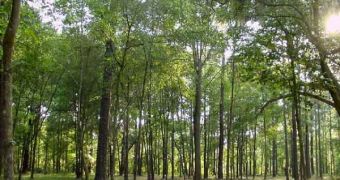Under normal conditions, forests around the world are able to absorb approximately 20 percent of all carbon dioxide emitted by humans from burning fossil fuels, such as oil, coal and natural gas. This amounts to a massive 4.8 billion tonnes of CO2 each year, an extremely large quantity that would otherwise be left in the atmosphere, further accelerating the global warming process. Over the last years, an additional carbon sink has been found to exist in Africa, one that has the potential to attract roughly 1.2 billion tonnes of carbon all by itself.
In a study published yesterday in the journal Nature, a 40 year-long research reveals that rain forests in Africa, which make up for a third of the total amount of forests in the world, have attracted at least 0.6 tonnes per year per hectare over the past decades. This is a very important find, as it illuminates scientists as to another mechanism that is involved in the complicated circuit that carbon undergoes after it's released by either humans or volcanoes.
If left untouched, such massive areas of forest are more than able to at least partially protect us from the influence of climate change, but unfortunately human activities are decimating them, causing severe imbalances both in the ecosystems they house and in the flow of carbon on Earth. At the same time, various atmospheric fronts are disturbed, which explains why more and more intense weather events are expected to hit various areas of the world over the next years and decades.
“We are receiving a free subsidy from nature. Tropical forest trees are absorbing about 18% of the CO2 added to the atmosphere each year from burning fossil fuels, substantially buffering the rate of climate change,” Royal Society research fellow Dr Simon Lewis, from the University of Leeds, who is also the lead author of the new paper, explains. “Whatever the cause, we cannot rely on this sink forever. Even if we preserve all remaining tropical forest, these trees will not continue getting bigger indefinitely.”
“It's well known that about half of the 'missing' carbon is being dissolved in to the oceans, and that the other half is going somewhere on land in vegetation and soils, but we were not sure precisely where. According to our study, about half the total carbon 'land sink' is in tropical forest trees. Predominantly rich polluting countries should be transferring substantial resources to countries with tropical forests to reduce deforestation rates and promote alternative development pathways,” the scientist concludes.

 14 DAY TRIAL //
14 DAY TRIAL //